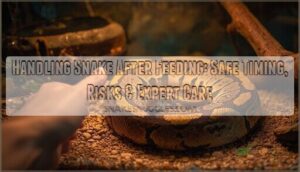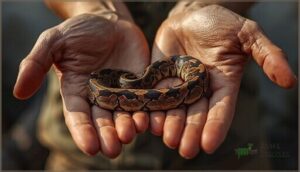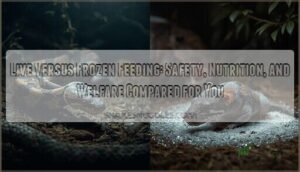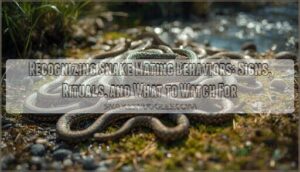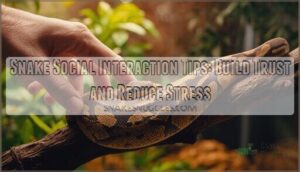This site is supported by our readers. We may earn a commission, at no cost to you, if you purchase through links.
Your ball python just swallowed a rat, and now you’re wondering if you can pick her up to check on that stuck shed. Stop right there. Handling a snake after feeding isn’t just uncomfortable for your pet—it can trigger regurgitation, a physiological event that damages the esophagus, depletes critical electrolytes, and leaves your snake vulnerable to secondary infections.
The digestive process demands intense metabolic focus, and any disruption sends stress hormones flooding through your snake’s system. Most keepers don’t realize that even gentle handling during this vulnerable window can force a defensive strike or cause your snake to expel an undigested meal.
Understanding the right timing and recognizing your snake’s readiness signals protects both digestive health and your relationship with your animal.
Table Of Contents
- Key Takeaways
- Why Handling After Feeding is Risky
- How Snake Digestion Works
- Factors Influencing Digestion Time
- Recommended Waiting Periods After Feeding
- Recognizing When a Snake is Ready
- Safe Handling Techniques Post-Feeding
- Common Mistakes to Avoid
- Managing Stress and Aggression
- Post-Feeding Care and Monitoring
- Frequently Asked Questions (FAQs)
- How do you handle a snake after feeding?
- How long after feeding should you give a snake?
- Can you hold a snake after it eats?
- How do you handle a pet snake?
- How long should you handle a snake?
- How long after feeding a python can you eat a snake?
- Can I feed my snake during shedding?
- What substrate is safest after feeding time?
- How often should adult snakes be fed?
- Do snakes drink water after eating meals?
- Conclusion
Key Takeaways
- Wait at least 48 hours before handling your snake after feeding to prevent regurgitation, which damages the esophagus, depletes electrolytes, and increases infection risk.
- Temperature directly controls digestion speed—snakes need stable thermal gradients between 80-85°F and access to warm zones after meals to process food efficiently.
- Read your snake’s body language carefully: defensive postures like S-shaped coiling, hissing, or rigid muscles signal stress and mean you should delay handling regardless of the time elapsed.
- Large meals, juvenile snakes, and sick individuals require extended waiting periods of 72-96 hours or longer because their digestive demands and metabolic responses differ from standard feeding situations.
Why Handling After Feeding is Risky
Picking up your snake right after a meal isn’t just uncomfortable for the animal—it can actually trigger serious health problems. When you handle a snake during digestion, you’re putting physical pressure on a system that needs to work undisturbed.
Handling your snake right after feeding puts physical pressure on a digestive system that needs to work undisturbed
Let’s look at the three main risks you’re taking when you handle too soon.
Regurgitation Risks and Consequences
When you handle your snake too soon after feeding, regurgitation becomes a real threat. This forceful expulsion can cause esophageal damage from gastric acid exposure and lead to serious electrolyte imbalance through fluid loss. Weight loss follows quickly, especially if regurgitation repeats.
Secondary disease risks climb as damaged tissue invites infection. You’ll also notice behavioral changes—your snake may hide more and refuse food, signaling ongoing stress and discomfort.
It’s important to note that husbandry problems are a common cause of regurgitation.
Stress-induced Defensive Behaviors
Beyond regurgitation, your post-feeding handling can trigger stress-induced defensive behavior. Snakes with elevated stress hormones are considerably more likely to strike when approached. You’ll notice hissing, mock strikes, or tight clutching—all stress signals tied to hormonal correlates of defensive responses.
Handling-related triggers like sudden movements compound environmental stressors. Distinguishing responses helps: defensive strikes generally follow S-shaped coiling, unlike direct feeding lunges toward prey-like stimuli.
It’s important to recognize that tail shaking indicates the snake feels threatened.
Impact on Digestion and Snake Health
Premature handling disrupts snake digestion through metabolic stress, diverting energy from digestion to stress responses. Temperature significantly impacts digestion efficiency—removing your snake from its warm enclosure slows gastric activity.
Handling snakes after feeding without proper waiting creates regurgitation effects: nutrient absorption drops, and factors affecting digestion time worsen. Consequences of handling too soon include compromised body condition over multiple feeding cycles.
How Snake Digestion Works
Understanding how your snake’s digestive system operates helps you make smarter decisions about handling timing. The process isn’t as simple as food in, waste out—it’s a complex biological event influenced by multiple variables.
Three key elements shape how quickly and efficiently your snake digests its meal: the timeline of the digestive process itself, the environmental conditions surrounding your snake, and the characteristics of the prey you’re offering.
Digestive Process Timeline
Understanding the snake digestion process begins the moment your snake swallows its meal. Early digestion kicks in within 12–24 hours as metabolic rate spikes up to 40 times baseline.
For typical-sized meals, factors affecting digestion time mean most snakes complete digestion in 3–5 days. Large prey extends this timeline to several weeks.
Completion indicators include reduced swelling and defecation, signaling physiological changes have concluded.
Role of Temperature and Environment
Temperature acts as the master switch for your snake’s digestive efficiency. Ambient temperature directly controls metabolic rate—wandering garter snakes reach peak digestion between 25–35 °C, while temps at 10 °C trigger complete regurgitation. Your snake enclosure needs a proper thermal gradient so your pet can move to warmer zones after eating.
- Provide thermal gradients with warm-side temps near 31 °C and cool zones around 25 °C
- Monitor environmental temperature daily, as cold conditions slow enzyme activity drastically
- Maintain humidity levels to prevent dehydration, which lowers digestion efficiency
- Avoid microhabitat effects like fluctuating temps that stress your snake’s system
- Understand metabolic costs rise sharply post-feeding, demanding stable environmental factors
Effects of Meal Size and Prey Type
When your snake swallows a mouse equal to 40% of its body mass, regurgitation becomes likely—studies on vipers show digestive failure at this threshold. Meal size dictates how long digestion lasts and how much energy your snake burns. Prey type matters too: fish digest faster than mammals, while frozen prey thawed properly promotes smoother nutrient absorption than risky live prey.
| Meal Size (% Body Mass) | Digestion Duration |
|---|---|
| 5% | 54 hours |
| 20% | 120 hours |
| 40% | 212+ hours (high regurgitation risk) |
| 100%+ | Up to 20 days |
| Oversized meals | Incomplete digestion common |
Factors Influencing Digestion Time
Digestion time isn’t one-size-fits-all—it shifts based on factors you can observe and control. Your snake’s species, age, and overall health play major roles in how quickly food gets processed.
Temperature and humidity levels in the enclosure also directly affect metabolic efficiency, so understanding these variables helps you make better handling decisions.
Species-specific Metabolic Rates
Not all snakes digest at the same pace. Ambush species like pythons can reach peak metabolic rates 44 times their baseline—one of the highest among vertebrates—while active foragers show smaller increases. Allometric scaling means larger snakes have proportionally lower mass-specific metabolic rates.
Meal size directly drives intestinal upregulation and thermogenesis effects, with specific active action consuming roughly 32% of prey energy in sit-and-wait hunters.
Snake Age and Health Status
Younger snakes digest faster because juvenile digestion runs two to three times quicker than in adults—they feed every five to seven days versus every one to four weeks.
Health issues in snakes dramatically slow this process; infections, parasites, and chronic disease compromise gastric motility and nutrient absorption.
Postfeeding care for snakes means waiting longer if your animal is young, ill, or recovering, reducing handling risks and metabolic stress.
Environmental Temperature and Humidity
Your snake’s environment directly controls how fast it processes meals—think of temperature as the dimmer switch for reptile metabolism. These factors affecting digestion time demand attention:
- Maintain temperature gradients between 80-85°F for best snake digestion process
- Keep humidity levels stable to prevent dehydration during digestion
- Avoid snake handling after eating when shedding influence begins
- Monitor behavioral changes indicating metabolic impact on your snake
Proper environment equals efficient snake care and management.
Recommended Waiting Periods After Feeding
The 48-hour rule isn’t set in stone—it’s a starting point that shifts based on what your snake ate and its individual needs. Larger meals, certain species, and younger or compromised snakes all require adjustments to this baseline.
Here’s how to determine the right waiting period for your specific situation.
Standard 48-hour Guideline
You should wait at least 48 hours before handling snakes after feeding—this minimum waiting period is a cornerstone of husbandry practices and stress reduction. Handling too soon disrupts the snake digestion process, causing digestion complications like regurgitation.
This recommended waiting time prevents consequences of handling snakes too soon, supporting proper postfeeding snake care across species, though species variation means some individuals need even longer.
Adjustments for Large Meals or Species
Large meals demand longer waiting periods—72 to 96 hours is safer when you’ve offered substantial prey. A meal equal to 25% of body weight extends digestion by days compared to smaller prey. Post-feeding observation helps you recognize when your snake has processed its meal completely.
Species metabolic rate matters too: big boas and pythons digest more slowly than corn snakes, so handling larger snakes requires patience.
Extended Waiting for Juveniles or Sick Snakes
Your juvenile or sick snake needs even more patience—extend waiting to 5 to 6 days after feeding. Juvenile digestion runs slower despite higher metabolism, and sick snake care demands extra caution to prevent regurgitation recovery setbacks.
Watch for handling indicators like normal activity and defecation before you resume contact.
Extended fasting protects compromised immune systems, and following these handling guidelines reduces snake stress dramatically.
Recognizing When a Snake is Ready
Your snake won’t send you a text message when it’s ready to be handled, but it will give you clear signals if you know what to look for. Reading these cues correctly protects both you and your snake from unnecessary stress or health complications.
Pay attention to three key areas: behavioral changes that indicate digestion is complete, warning signs of discomfort, and symptoms that something has gone wrong.
Behavioral Cues Post-digestion
Once your snake resumes normal activity—exploring its enclosure with a calm demeanor and relaxed posture—digestion is likely complete. You’ll notice increased alertness signs like tongue flicking, which indicates renewed sensory engagement with the environment.
This shift in snake behavior after feeding, from hiding to active exploration, signals that the metabolic demands of digestion have eased. Observing this postfeeding behavior helps you identify the safest window for handling.
Signs of Stress or Discomfort
Even when digestion appears complete, your snake’s body language reveals hidden stress. Defensive postures—rigid coils, rapid tongue flicking, or an elevated S-shaped neck—indicate discomfort that can trigger regurgitation, upset, or reduced feeding.
Over 80% of stress events involve tightened muscles and escape attempts. Recognizing these stress signals prevents handling errors that increase stress hormones and compromise your snake’s health.
Monitoring for Regurgitation Symptoms
Early indicators like repetitive throat contractions or increased restlessness usually emerge 24–72 hours before visible regurgitation. You’ll notice partially digested prey with foul odor, clear oral secretions, or pacing behavior—systemic effects that demand immediate attention.
Risk periods peak within 48 hours post-feeding, when preventing snake regurgitation depends on recognizing these signs of regurgitation and stress. Consequences include weight loss and compromised immunity, requiring veterinary care for repeated episodes.
Safe Handling Techniques Post-Feeding
Once your snake shows signs it’s ready for interaction, proper handling technique makes all the difference.
The right approach protects both you and your snake from injury or stress.
Here’s what you need to know before reaching into that enclosure.
Washing Hands and Hygiene
You can’t see bacteria with your naked eye, but they’re everywhere on your snake’s skin. Hand hygiene stands as your first defense against preventing Salmonella and other pathogens that colonize nearly half of captive reptiles.
Here’s how to implement safe snake handling through proper handwashing techniques:
- Scrub your hands with soap and water for at least 20 seconds immediately after handling your snake or its enclosure items—alcohol rubs won’t cut it when hands are visibly soiled.
- Apply surface disinfection protocols to feeding tongs, water bowls, and any household surfaces your snake or its equipment contacts, especially after handling feeder hygiene items like thawed rodents.
- Keep snakes out of kitchens and dining areas to prevent cross-contamination of food preparation zones.
- Supervise children’s hygiene rigorously—young handlers face higher infection risk and need immediate handwashing after any reptile contact.
These handling precautions reduce transmission risk not just for you, but for vulnerable household members who may never directly touch your snake yet still encounter bacteria on contaminated surfaces.
Supporting The Snake’s Body Properly
With both hands beneath your snake, you’ll achieve even weight distribution that prevents spinal injury—a critical handling precaution often overlooked. Support one-third to half its body length at multiple points, never gripping the tail alone. Larger species demand species-specific support from additional handlers.
These gentle handling techniques maintain proper posture and hygiene while supporting the snake’s body correctly, reducing stress that disrupts post-feeding digestion.
Avoiding Sudden Movements and Stress
Quick, jerky motions trigger your snake’s antipredator response, flooding its system with stress hormones that disrupt digestion. Motion-induced stress activates fear pathways, so adopt a gradual approach using slow, predictable handling in a calm environment.
Position yourself within its field of vision before reaching in, minimizing threats through deliberate movements. This attention to snake behavior transforms safe handling techniques into routine practice, avoiding sudden movements that compromise post-feeding recovery.
Common Mistakes to Avoid
Even experienced snake keepers can fall into common traps that put their animals at risk. You might think you’re doing the right thing, but certain mistakes can trigger regurgitation, stress, or defensive bites.
Let’s look at the missteps you need to avoid after feeding your snake.
Handling Too Soon After Feeding
Premature handling disrupts snake digestion more dramatically than most keepers realize. When you handle a snake too soon after feeding, you’re gambling with consequences that extend far beyond a single regurgitation event.
Five stress indicators and handling consequences that emerge from premature handling:
- Regurgitation causes immediate nutrient loss and damages esophageal tissue, often requiring 1–2 weeks of fasting for recovery.
- Digestive disruption slows gastric motility, leaving prey unprocessed and increasing infection risk.
- Stress and agitation trigger defensive strikes, undermining the trust you’ve worked to build.
- Chronic poor growth results when waiting time before handling snakes is repeatedly ignored.
- Visible distress—restlessness, escape attempts, open-mouth breathing—signals your timing was off.
Understanding snake digestion means respecting that the first 48 hours post-feeding represent a vulnerable window where handling a snake can derail weeks of care.
Ignoring Snake Body Language
Your snake’s body language is a real-time stress monitor—and ignoring it invites trouble. Defensive postures like tight coiling and head retraction signal that handling a snake right now will escalate physiological stress and trigger escape behaviors.
Over 70% of defensive responses involve strike-ready postures you can’t miss. Repeated disregard for these stress signals leads to behavioral changes, chronic regurgitation behaviors, and long-term aggression—consequences of handling snakes too soon that undermine trust and health.
Disrupting The Enclosure Environment
Beyond misreading your snake’s signals, disrupting the enclosure environment after feeding compounds stress through multiple pathways. Temperature fluctuations from repositioning heat sources, humidity changes from aggressive ventilation, and cleaning disturbance all interfere with digestion.
Lighting stress from sudden brightness shifts and security concerns from removing hides trigger defensive snake behavior.
Minimize enclosure changes for 48–72 hours—snake handling waits, but stable conditions can’t.
Managing Stress and Aggression
Stress and aggression in snakes often stem from poor handling practices, especially around feeding time. You can reduce these reactions by building a foundation of trust, controlling environmental triggers, and reading your snake’s warning signs.
The following strategies will help you create a calmer, safer interaction with your snake.
Building Trust With Your Snake
Trust isn’t granted—it’s earned through consistency and patience. Building a positive bond with your snake requires deliberate, thoughtful interactions that respect its natural boundaries and stress responses.
To establish trust, follow these key practices:
- Limit handling sessions to 1–2 times weekly, avoiding the 24–48 hours after feeding to prevent negative associations with being picked up.
- Wash your hands beforehand to eliminate prey-like scents that might trigger feeding responses or confusion during safe interactions.
- Support the snake’s body fully with slow, predictable movements—sudden motions increase perceived predation risk and defensive strikes.
- Practice gradual desensitization by slowly increasing duration while watching for stress signals, promoting calmer responses over time.
- End sessions early when you notice stress behaviors rather than forcing continued contact, reinforcing neutral or positive reinforcement patterns.
Gentle handling combined with proper snake communication creates a foundation where your snake learns that interaction doesn’t equal danger. Observe body language closely—tight coiling, hissing, or rigid posture indicate fear, not comfort. Allowing your snake to control when contact begins and ends reduces fear conditioning considerably. Over weeks and months, this patient approach transforms defensive reactions into relaxed exploratory snake behavior, demonstrating genuine progress in building trust and safe snake handling for both of you.
Minimizing External Stressors
Once you’ve established trust through consistent handling, your next priority is controlling the enclosure’s surroundings. Noise reduction and vibration dampening are critical—construction noise at 70–80 dB can increase stress hormones by up to 50%. Light control matters too, since bright flashlights and continuous illumination disrupt rest periods when your snake needs privacy most.
Proper snake handling begins with stress reduction long before you open the enclosure. A safe enclosure positioned in a quiet, low-light area dramatically lowers baseline anxiety, reducing defensive reactions during interactions and supporting healthy digestion after feeding.
| Stressor Type | Practical Solution |
|---|---|
| Noise | Relocate enclosure away from high-traffic hallways, appliances, and loud music |
| Vibration | Use rubber mats under racks to dampen slamming doors and footsteps |
| Light | Provide dark hides and avoid flashlights during post-feeding rest |
| Visual traffic | Position tank away from windows and frequent household movement |
| Predator exposure | Keep enclosures out of sight from dogs, cats, and other perceived threats |
Recognizing Defensive Postures
Even in a calm environment, you need to read your snake’s body language before handling. A coiled posture with an S-curved neck, hooding signals in species like cobras, and acoustic warnings—hissing or rattling—all mean back off.
Open-mouth threats and rapid tongue-flicking indicate heightened snake aggression. Many snakes favor fleeing behaviors over striking, but ignoring these cues can trigger defensive bites you could have avoided.
Post-Feeding Care and Monitoring
Once your snake has eaten, your job doesn’t end with leaving it alone. Proper post-feeding care involves maintaining a clean environment, watching for signs of health problems, and knowing how to respond if something goes wrong.
Here’s what you need to focus on after feeding time.
Enclosure Cleaning Routines
Once your snake has eaten, you still need to maintain a clean home—just adjust your timing. Spot-clean feces daily, but schedule deep disinfection for 48 hours after feeding when stress and regurgitation risk drop.
Essential post-feed cleaning practices:
- Use reptile-safe cleaner like diluted bleach (1:32) or F10SC to control zoonotic risks from Salmonella
- Replace soiled substrate sections immediately to prevent ammonia buildup and waste management problems
- Avoid major enclosure disruption within 24 hours of feeding to minimize handling stress
Monitoring Health and Appetite
How often do you check if your snake’s eating habits match its normal pattern? Track feeding frequency—adults generally eat every 1–2 weeks—and watch for appetite indicators like increased tongue flicking or sudden refusal.
Monitor weight monthly to catch gradual loss. Behavioral changes, lethargy beyond 2–4 weeks, or visible regurgitation signs demand veterinary assessment to protect snake health and prevent serious illness.
Steps to Take After Regurgitation
After regurgitation, withhold all food for 10–14 days to allow digestive disruption to heal. Remove regurgitated material immediately, apply biosecurity measures by disinfecting surfaces, and provide hydration support with clean water access.
Watch for stress consequences like lethargy or repeated events—both demand vet intervention.
When resuming feeding adjustments, offer prey half the usual size. Your veterinarian can guide probiotics and assess whether further treatment is needed.
Frequently Asked Questions (FAQs)
How do you handle a snake after feeding?
Think of your snake’s belly like a loaded backpack—you wouldn’t jostle it.
Wait at least 48 hours after feeding before any handling, ensuring digestion completes and preventing regurgitation through gentle handling and respectful interaction.
How long after feeding should you give a snake?
You should wait at least 48 hours before handling your snake after feeding. This minimum waiting time allows proper digestion and greatly reduces regurgitation risks while supporting healthy snake behavior after feeding.
Can you hold a snake after it eats?
You shouldn’t handle a snake right after it eats. Handling disrupts digestion and triggers defensive snake behavior.
Snake stress increases regurgitation risk, leading to serious consequences of handling too soon and common mistakes owners make.
How do you handle a pet snake?
Proper snake handling starts with hand washing and a gentle approach. Support your snake’s body with both hands, never grabbing its head or tail.
Watch snake behavior—move slowly and read its cues for safe handling.
How long should you handle a snake?
Most snakes tolerate 10–15 minutes of handling per session, though duration depends on temperament and size. Frequent, shorter interactions build trust better than extended sessions, which can stress even calm individuals.
How long after feeding a python can you eat a snake?
Pythons don’t usually engage in cannibalism, but if prey availability is extremely limited, ethical concerns and dietary needs take priority.
Snake digestion of another snake follows standard postfeeding care—wait 48 hours minimum before handling.
Can I feed my snake during shedding?
Feeding during shedding isn’t ideal. Reduced vision and metabolic demands increase regurgitation risk and stress, though some snakes show feeding tolerance.
Wait until clear eyes return—shedding appetite generally rebounds, supporting better snake health and behavior.
What substrate is safest after feeding time?
Regarding substrate ingestion, paper beats particulate every time. Non-loose options—paper towels, tile, reptile carpet—eliminate impaction risks juveniles face, simplify cleaning ease, and suit most species needs without bioactive concerns or safe reintroduction delays.
How often should adult snakes be fed?
Most adult snakes thrive on a feeding schedule of once every 7–14 days, though individual needs vary by species, metabolic rate, prey size, and age influence—tailor your snake care approach to maintain best snake health.
Do snakes drink water after eating meals?
Yes, snakes drink water after eating meals. Post-meal hydration increases because snake digestion creates a water deficit.
Drinking frequency rises during this period, so always provide fresh water to support proper water balance and prevent dehydration effects.
Conclusion
Picture your snake coiled peacefully in its hide, metabolism working through every gram of prey without interference. That image depends entirely on your restraint. Handling a snake after feeding isn’t a gray area—it’s a direct threat to digestive success and long-term health.
Wait the full 48 hours minimum, read your animal’s signals, and let biology run its course. Your patience now prevents regurgitation, stress, and veterinary emergencies later. Respect the process, protect your snake.
- https://reptifiles.com/ball-python-care-guide/ball-python-handling-tips/
- https://www.reddit.com/r/snakes/comments/l0h8di/how_long_do_you_guys_wait_to_handle_your_snake/
- https://www.youtube.com/watch?v=BU01P6aEJ-o
- https://ultimateexotics.co.za/regurgitation-and-vomiting-in-snakes/
- https://pmc.ncbi.nlm.nih.gov/articles/PMC6206181/

